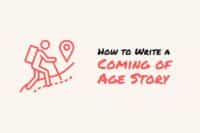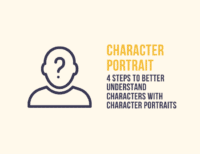Yes, we'd all like more traffic, more comments, more readers on our blogs. But if you're writing a blog, there's one thing you want even more than readers. You might not admit that you want this. You might not even realize it! But it's behind that emptiness you feel every time you're disappointed after checking your blog stats. What is it?
Connection.
None of us started a blog to make a lot of money or build a brand. There are easier ways to do that.
No, you start a blog because you want to connect with people who might understand you.
How to Write a Blog Post that Connects
When I started The Write Practice in 2011, I knew I wanted to connect with other writers. I had studied writing in college and had even written professionally for a few years, but I hadn't found my people, my tribe, if that makes sense.
I started The Write Practice to teach writing, but I also started it as a way to connect, to create a learning community where we could all grow into better writers together.
However, for the first six months, I felt like I was just talking to myself. Every day, I would hit publish expecting for my post to connect, but nearly every day, my posts would fall flat. I couldn't figure out how to connect the way I wanted.
I eventually realized that the reason I wasn't connecting was that my posts weren't good enough. When I look back to those original posts, I cringe a little inside. I had great intentions, but at the time, I didn't have the skills to attract the readers I wanted.
How do you write a blog post that connects?
10 Steps to Writing a Blog Post
When I started blogging in 2007, I didn't have access to these tips. I just wrote whatever I wanted. These are the ten steps that I wish I had when I started. I hope they'll help you connect with your readers:
1. Choose your premise.
Your premise is your central argument or concept that the rest of your article will be proving, and it's important to have an idea of what this is before you start writing.
Not sure what your premise is yet? Here's a blog post designed to help you figure out your premise.
2. Start writing.
Don't overthink this. Just write. Don't waste time doing unnecessary research. You can research as you write. Start putting your fingers to the keys. You need to find your rhythm or else you might never finish your blog post. Once you get started, once you get a few solid chunks of text on the page, it's a lot easier to keep going.
Feeling stuck? Here's a post to break your writer's block.
3. Fill in your template.
When I first started blogging, I didn't have a specific format that I used. I just threw up whatever words I thought sounded right. But as I've learned and grown as a writer and a blogger, my posts have inevitably fallen into a few different templates. I encourage you to experiment with multiple different templates, including this “perfect” blog post template, to see what works for you.
Not sure what a blog post template is? Here's an article that will help.
4. Write your headings.
Online readers tend to skim, and headings enable people to get the core points of the text quickly. Headings can also act as speed bumps for the eye, helping them slow down and take in the text. In short, smart bloggers use headings.
Headings are especially important for SEO. The little robots from search engines pay special attention to them, so they're extremely useful, both for your readers and for your marketing.
Not sure how to create them? Here's a quick guide on using headings.
5. Begin in the middle, with your core points.
Once you have a loose structure, you can start to craft the meat of your post, your core points. If you're using the “perfect” blog post template, this section is where you finally solve your readers' problem. As a reminder, here's where it fits in the outline:
- The Lead (“What's the problem?”)
- The Aggravator (“Why is this problem so tough to solve?”)
- The Core Points (“The solution to the problem”)
- The Conclusion
- The Question
Wait a second, though. Isn't this the middle of the post? Why don't we start writing by focusing on the lead?
It's usually easier to write your lead after you write out your core points, your solution. Why? Because as you write out your solution you're going to get a much better sense of the scope of the problem you're solving for your readers.
I also like starting in the middle because it frees you from having to write your post in order, which can often get you stuck and lead to writer's block.
6. What's the problem?
Now, it's time to craft the first few lines of your post. To make sure that they keep reading after these first few sentences, you need to create a deep connection with them.
How do you do that? By identifying a felt need.
What do your readers' want?
What are they struggling with?
You know what your readers want the best (and if you don't know, then maybe you need to get to know them).
7. Make the problem harder.
After you pose the problem in the lead, the next step is to show why this problem is so difficult to solve. I call this step the “aggravator,” and it's a great place to connect with your readers, to tell a story, and to show people you understand what they're going through.
In other words, this is where you talk about why their problem matters.
8. Conclude by wrapping up the lead.
Too many good bloggers don't write a conclusion for their posts, and they're missing out.
I know writing a conclusion is so high-school-english-paper, but the conclusion a great place to connect the dots, to show your reader how your solution actually solves their problem.
9. Catch your readers' attention with your headline (the most important step!)
Your headline needs to instantly explain what the reader is going to get from the post. Vague headlines will destroy any chance of your post catching the attention of readers.
10. Read, re-write, and proofread
It goes without saying, but before you hit publish, don't forget to read what you wrote and make any necessary changes. Don't have time to edit? Check out these three techniques to edit a blog post in five minutes.
Also, make sure your post is the write length. Here's our guide on the ideal blog post length.
By the way, have you ever wondered why you miss typos even after reading over your writing several times? Here's a fascinating post about why we miss our own typos.
How about you? What steps do you take to write a blog post?
PRACTICE
Today, give these ten steps a try! Write a blog post using this format, and publish it on your blog. When you're finished, copy and paste the link into the comments section below!








You, Joe Bunting, are a very good teacher. Always clear and to the point. The only thing I might respectfully add is something The Write Practice does that I wish EVERY BLOG ON THE PLANET DID: You’ve downloaded and incorporated DISQUS.COM in your comments.
That way, ANYONE who comments on my comment, or I leave a remark on theirs, we’ll get an email. This just ENCOURAGES dialogue with each other, with helps with the connection you were talking about. Thank you!
How do you incorporte DISCUS.COM for blog comments? My blog is with Blogspot.com, and I get very few readers and fewer comments. Perhaps the real problem is that my blog posts are not interesting.
Adelaide – it’s been awhile since I downloaded it (it’s free), but go to http://www.disqus.com and it walks you through it. Good luck.
Good point. I do love the disqus comments on here. Maybe I will look into it myself.
Go for it, Sandra!
Thanks Marcy! I appreciate that. Agreed on Disqus. It’s a bit intimidating when you’re first getting started, but after that, it’s wonderful. Thanks Marcy. 🙂
Yet another great post from you, Joe. Informative and helpful!
Thanks Emelia! So glad it helped.
I started to do the steps, but stopped after step one because it didn’t seem to apply to what I wrote, but I definitely do want to write something informative and give it a try. Anyway I wrote: “Past and Present. Loss and Gain” http://writeitonmywall.wordpress.com/
Thanks for sharing your post Sandra. I think the premise definitely still applies to you. In the case of this post, your premise would be something like “the experience of depression.” Does that make sense?
You know I’ve never considered doing a blog. (Nor would I know how to get started or maintain it). I think I’d like to give it a try but I am absolutely blind in this field. Any suggestions?
You should try it. It’s one of the most powerful tools writers have at their disposal today. To get started, why not try creating a free wordpress blog: http://wordpress.com/
I run a blog about creative writing.
I start, of course, by becoming clear about the topic and about what I want to express/conclude. After that, I make an outline on several sheets of paper; these are just wildly scribbled notes (I should probably mention that my posts are very long, about 3000 words plus long literary quotes).
Then I think about the headline: I could also do this at a later point, but I get quite creative with headlines and don’t worry too much about keywords, so my creative motor is usually already working on it automatically at this point. I spend a good amount of time thinking about the beginning and first paragraph, choosing one out of several interesting angles: Could be to start with an interesting fact about an author, could be some outrageous and provoking claim/idea, something personal from me, an interesting question that leads to the core of the problem, etc… all of the classical techniques.
After that, not surprisingly, I sit down in front of the laptop to write the whole thing from top to bottom, according to the four-part (or 5-part) structure I have for my posts.
The first revision is mainly to make sure that all the content I want is in there, and also that there is no superfluous or repetitive content included. It’s also about structuring the whole piece the right way, and almost always I make at least some minor changes in structure.
The other revsions take care of the text sounding well, they are about vocabulary, grammar and rhythm of language.
I let somebody proofread it and go over his suggestions for improvement. Then, finally, the piece is ready for publication.
My blog is pretty new, here is a post about the techniques Shakespeare uses to establish plot in “Macbeth”:
http://www.ridethepen.com/shakespeare-macbeth-plot/
Wow that sounds cool.
Thanks, Sandra!
And Joe, you put all the basics there in a nutshell, very useful article!
Thanks Alex! I tried.
I love the level of thought you put into your blog posts, Alex. Thanks for sharing your process.
Awesome, thanks! That comment of mine was a novel in itself…
Great post Joe. Extremely useful. Thank you.
Dawn
You’re very welcome, Dawn. Thank YOU for reading. 🙂
This is so helpful, Joe! After years of saying I’m going to blog, I’m finally writing blog posts. Haven’t posted yet, but at least I’m working on some potential posts.
I have written an article today this is my debut to writing.
Please take a look I am super excited about the feedback .
That will be really kind of you.
” A TRIP OF THOUSAND MILES MUST BEGINS WITH A SINGLE STEP”
Lao Tzu,Founder Of Taoism(about 500BC)
Hello Everyone,
It’s early morning and I’m just about to start my work.I
open my laptop and see this beautiful quote on the
wallpaper.I read it once and again and again perhaps more
than 5 times.Something comes to my mind and I’d like to
share.
I enquired to myself. Really? What is it exactly about? A
number of thoughts are coming in my mind,I actually don’t no
what to write and what not but since this is the first time
I’m gonna write everything what I have right now.
You Don’t need worry as these are the simple words with a
simple meaning ,everyone know I think.But the question comes
here then what was the need to write or say such a thing?
Now relating it to some practical things of life.What is life
?Isn’t it a joureny? Ohh yes it is.We born then grow and go
through a lot and then one day it comes to an end,the same
properties a trip have.I mean we start, move on and finally
reach.Taking another example think about any task,if we want
it done,we need to start somewhere process and its done.Now
its getting me a feel of its worth.It seems like a rule of
procedure for every thing which happens.
Aother part is that we discussed three steps but the only
first one is written in the quote.Whenever we consider
something, questions arise.There must be something more.
Now the worthy thing is that the first part is of the
greatest importance.In each and every trip the first step is
most important because this tells that whatever is our goal,
we need to start from a smaller step.These smaller steps are
the bases of the building we are trying to make.Many times
people make plans but that does not take them to success
because they do not make their first move corresponding to
it.And the bitter truth is things never happen on their own.
We need to take action for the first step.And after it, it
becomes easy to move on because this first step provokes
second and second to third.Like in case of a vehicle to move
it requires more stuff to start moving and then comparatively
less to continue. But why?Because this is the natural low of
happenning things. When we consider about a new startup the
first step is judgemental.
Sometimes people misunderstand by ignoring the smaller steps
while having larger goals,this lead them away from success
since because no one can make a good building on a weak base.
So it doesn’t matter that how long is your joureny, the
smaller steps count a lot.The very first step gives you many
things a way,a destination,a hope,a feel of satisaction that
you are working on and valour to achieve what you want.
Now it seems like the whole story is written in the very
first step.So what do you think now?
You may consider it as a story or a procedure or anything
else.But what I consider of it is that its like a medicine
to the tiredness of consideration,confusion,fear of
predictable pros and cons and all of your concerns which provides a valour and a blink of hope and recollects the scattered parts of mind to be able to take a worthy and healthy decision.